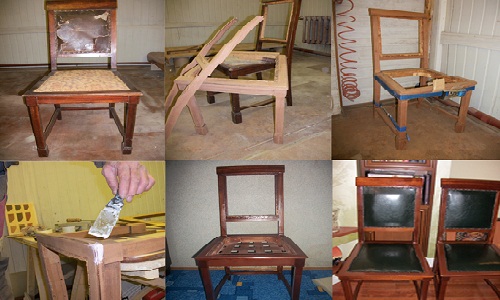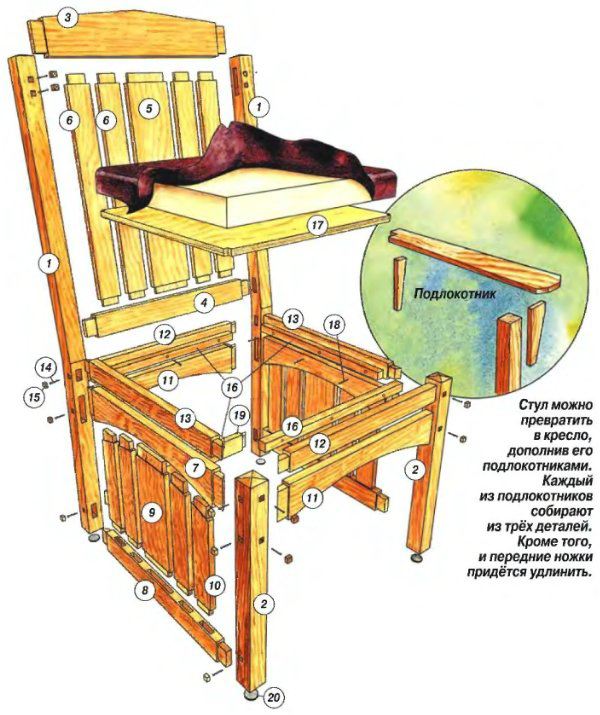Do-it-yourself chair repair will not only allow you tosave money, but also give the old thing a second life. With minimal costs, you can radically change the appearance of the furniture, everything will depend only on your imagination and the materials you choose. Thanks to restoration, any “old” chair will belook like new. Before repairing a chair, you need to familiarize yourself with the detailed technology, this will allow you to avoid serious mistakes and do everything correctly.
Thanks to restoration, any “old” chair will belook like new. Before repairing a chair, you need to familiarize yourself with the detailed technology, this will allow you to avoid serious mistakes and do everything correctly.
Upholstery of an old chair
You will need:
- nailing;
- pliers;
- small nails and a hammer (furniture stapler);
- upholstery fabric;
- sackcloth;
- dense wide tape;
- dense fabric (canvas, tarpaulin);
- batting or sintepon;
- coconut fiber.
Repair the chair if it has not deteriorated over time.has suffered greatly and looks quite decent, you can replace the upholstery. First, you need to remove the seat, then use a nail puller to remove the old nails, carefully remove the fabric, take out the rest of the contents and springs. Tools for reupholstering a chair:stapler, screwdrivers, pliers, drill, jigsaw, screwdriver. It is important to remember the sequence of disassembly - then it will be easier to reassemble the seat. Assess the strength of the upholstery materials, those that are still in good condition can be left, and those that have already served their purpose are better replaced with new ones. Do not leave old nails under any circumstances - this will greatly complicate the subsequent work, especially when using a furniture stapler. Repairs begin with attaching a thick tape to the seat frame, it is best to do this with a furniture stapler. But not every family has such a tool, and buying it to repair a couple of chairs is impractical, so you can use short furniture nails and an ordinary hammer. The tape is nailed in the form of a lattice, intertwining verticals and horizontals with each other, you should get some kind of wickerwork. The distance between the strips should not exceed 5 cm, the ideal option is 3-4 strips vertically and horizontally. In order to stretch the tape well, its end is wound on a wooden block. Burlap is nailed on top of the tape lattice, then springs are placed, sewn from below using a gypsy needle and strong twine, ordinary sewing threads are not suitable in this case. The main task is to secure the springs so that they become motionless. After this, they begin knitting, opposite each spring they hammer in a nail (not all the way), tie a thick rope on it (you can use clotheslinen or linen twine), hammer the nail in until it stops. Then each spring is tied from above, in this case it is easier to use a knot that is used for weaving nets. The knitting is done vertically, horizontally and diagonally, at the end of each row the rope is tied to a driven nail. It is very important to choose a dense twine that is difficult to break, since the service life of the new upholstery will depend on this.
Tools for reupholstering a chair:stapler, screwdrivers, pliers, drill, jigsaw, screwdriver. It is important to remember the sequence of disassembly - then it will be easier to reassemble the seat. Assess the strength of the upholstery materials, those that are still in good condition can be left, and those that have already served their purpose are better replaced with new ones. Do not leave old nails under any circumstances - this will greatly complicate the subsequent work, especially when using a furniture stapler. Repairs begin with attaching a thick tape to the seat frame, it is best to do this with a furniture stapler. But not every family has such a tool, and buying it to repair a couple of chairs is impractical, so you can use short furniture nails and an ordinary hammer. The tape is nailed in the form of a lattice, intertwining verticals and horizontals with each other, you should get some kind of wickerwork. The distance between the strips should not exceed 5 cm, the ideal option is 3-4 strips vertically and horizontally. In order to stretch the tape well, its end is wound on a wooden block. Burlap is nailed on top of the tape lattice, then springs are placed, sewn from below using a gypsy needle and strong twine, ordinary sewing threads are not suitable in this case. The main task is to secure the springs so that they become motionless. After this, they begin knitting, opposite each spring they hammer in a nail (not all the way), tie a thick rope on it (you can use clotheslinen or linen twine), hammer the nail in until it stops. Then each spring is tied from above, in this case it is easier to use a knot that is used for weaving nets. The knitting is done vertically, horizontally and diagonally, at the end of each row the rope is tied to a driven nail. It is very important to choose a dense twine that is difficult to break, since the service life of the new upholstery will depend on this. Scheme of chair assembly and re-upholstery.A thick fabric (canvas or tarpaulin) is attached over the springs, followed by a layer of coconut fiber, which is covered with batting or synthetic padding (can be replaced with furniture foam rubber), all this is secured with another layer of fabric. Next, the upholstery material is cut out; to make a pattern, it is enough to wrap the seat with newspaper. First, the upholstery is nailed in the center of one of the sides, then from the opposite edge. At the same time, make sure that the threads of the fabric do not skew. The corners are secured last; if necessary, the fabric is gathered into small folds. The edge of the upholstery can be finished with a cord or braid, the decor is glued using a glue gun. All that remains is to return the seat to its place. This can be considered complete. Return to contents</a>
Scheme of chair assembly and re-upholstery.A thick fabric (canvas or tarpaulin) is attached over the springs, followed by a layer of coconut fiber, which is covered with batting or synthetic padding (can be replaced with furniture foam rubber), all this is secured with another layer of fabric. Next, the upholstery material is cut out; to make a pattern, it is enough to wrap the seat with newspaper. First, the upholstery is nailed in the center of one of the sides, then from the opposite edge. At the same time, make sure that the threads of the fabric do not skew. The corners are secured last; if necessary, the fabric is gathered into small folds. The edge of the upholstery can be finished with a cord or braid, the decor is glued using a glue gun. All that remains is to return the seat to its place. This can be considered complete. Return to contents</a>
Removing old cover
You will need:
- sandpaper;
- cycle;
- putty on wood;
- putty knife.
In most cases, chair repairs begin withremoving old varnish. The easiest way to do this is to use sandpaper (sanding sponge) with medium grain, moistened with water. Under the influence of moisture, the varnish will soak and gradually come off. In this case, it is necessary to wash the clogged sandpaper in water from time to time. It is important to pay attention to the quality of the abrasive material; if it leaves a black mark when wet, then such sandpaper is not suitable for use. If you use a grinder to remove the old coating, then set it to the lowest speed, otherwise you can damage the wood. A special solvent for removing paint and varnish can only be used if the varnish cannot be removed in other ways. It is important not to exceed the permissible dose (read the attached instructions), otherwise the product will be absorbed into the wood, which will complicate subsequent processing. You can remove old cracked varnish using a scraper or broken glass; with careful movements, it is simply scraped off the surface. After this, the chair is sanded with fine-grained sandpaper, then the dust is removed with a rag. If there are places on the surface of the furniture that are damaged by woodworm, various chips and scratches, then they need to be restored. Repairs begin with treatment with a special insect repellent, then wood putty is applied (there is white and wood-colored putty). After the putty dries, it is sanded with fine-grained sandpaper. Which method of removing the old coating to choose is up to you, it all depends on the degree of damage to the varnish and the availability of tools. Return to the table of contents</a>
Toning, painting, waxing
You will need:
- furniture wax;
- woolen cloth;
- flutes (wide brush);
- stain or acrylic paint.
Furniture repair is not such a difficult task,if you know some nuances. So, tinting and varnishing can be replaced by waxing. You just need to choose a colored wax that will emphasize the texture of the wood, give it a beautiful shade and at the same time fix the result. Apply a thin layer of wax to a small surface using a woolen cloth. It is not advisable to return to the same place several times, otherwise dark spots may form that will be difficult to remove. To cover a large area, it is advisable to melt the wax in a water bath. In this case, it is more convenient to apply it with a wide brush. You can emphasize the wood texture with a stain, it is best to use alcohol, since it is easier to work with, besides, it gives a more saturated color than water. Stain is applied with a brush, you can mix colors to get the desired shade. After you have applied alcohol stain, you need to remove the excess (wash). Using a brush soaked in solvent, go over the surface of the chair. After the stain dries, you may notice raised wood fibers, which need to be sanded with sandpaper. When working with water-based stain, there is an important rule: you cannot return to the painted area, otherwise dark spots will appear. The work is fixed either with colorless furniture wax or covered with varnish. If the wood on the chair has lost its former attractiveness, it is better to paint it. First, the furniture is primed, then painted with acrylic paint. It is important to apply the paint in thin layers with mandatory intermediate sanding with fine sandpaper. You can use high-quality aerosol dyes, spray the paint from a distance of 40 cm in a very thin layer, let it dry, then apply it again. After each use, remove the sprayer and wash it in turpentine. Following these simple tips, you can easily repair a chair with your own hands.</ ul>


